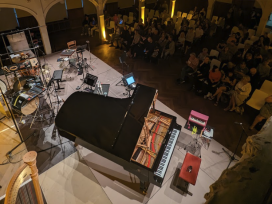According to an editorial in Sydsvenska Dagbladet a few years ago, unless stricter measures are taken against file-sharing networks, “the artistic world is facing one long amateur show night. Not to say a cultural twilight.” Without a market for digital files, warned bestselling novelist Liza Marklund recently, “we will all end up in the amateurs’ dingy basement”. To make matters worse, and as if to underline the gravity of the situation, these amateurs are often described as “enthusiastic”.
The idea of an amateur takeover is entirely at odds with the modernization theory which predicted a continuing and relentless increase in the division of labour. Cultural sociology has frequently described a transition from popular culture to mass culture as a manifestation of a comprehensive socio-economic rationalization, in which a constantly growing professionalization of culture has been viewed as inevitable.
This is a line that can no longer be discerned nowadays. It disappeared somewhere in the second half of the twentieth century into a teeming grey zone between professionalism and amateurism, impossible to pin down statistically. In Sweden, This tendency is most evident the musical field. Over the years, the trade union Svenska Musikerförbundet (The Swedish Musicians’ Union) has been torn between excluding and including successive new waves of amateurs as they took to the stage. By highlighting its history I hope to show that cultural professionalism is not a simple expression of an all-embracing economic logic, but generated and sustained by specific institutions.
The forms that this amateur/professional distinction assumes, however, are never permanent. The question of striking a balance between stability and flexibility, between security for established musicians and the opportunity for amateurs to get a foot in the door, has arisen time and again in the twentieth century – and in fact much earlier than that. Let me start by going several centuries further back in time.
Non-guildsmen and town musicians
The seventeenth century saw the establishment of the town musician system in Sweden. From the hordes of itinerant folk musicians, a select number of players were recruited, and attached to a particular town or city. A guild-like system developed, with apprentices, journeymen and clearly defined rules for who was and who was not allowed to play music in the town.
It was the task of the town musician to provide the town with music in a variety of official settings, predominantly in the churches and at town hall functions. For this he received some form of retainer – from the Church in certain towns, from the state in others, and in some places no wage at all. His main source of income remained performing at the private banquets and dances of the burghers. The town musician was granted a privilegium exclusivum to perform at such gatherings.
A letter of authority to the town musicians of Gothenburg in 1739 defined the privilege as an assurance that “neither shawm-blowers nor other unfamiliar non-guildsmen and others, from whatever class they may be, who are not ordinarie Towne Musicians shall have authorization at any such Solemnities”. The term “shawm-blowers” referred to the military musicians of the time, while “non-guildsmen” (in Swedish bönhasar, an archaic term with its roots in a word in northern German dialect for illicit craftsmen, which has resurfaced in modern times) was a general name for unauthorized musicians. (Translator’s note: In Bach’s time, such players were sometimes known as “beer fiddlers”.)
The town musician system began to loosen its hold in the first half of the nineteenth century, as the influence of the guilds began to wane. When freedom of trade passed into law in Sweden in 1864, every man’s right to the free choice of profession was ratified. This period also saw professional military bands start to give concerts on a significant scale, while amateur music-making flourished in middle-class circles.
Sergeant majors and jazzmen
Increasing urbanization, however, led to the opening up of new venues, leading to new conflicts. Exactly how great a role could amateur bands and ensembles be allowed to play without threatening the jobs of full-time musicians? No sooner had the Swedish Musicians’ Union been founded in 1907 than it began wrestling with the issue. In negotiations with amateur music associations in Stockholm and Gothenburg, it attempted to portion out the venues. The basic negotiating position of the Musicians’ Union was that the amateurs were free to play for as low a rate as they wanted, as long as they restricted themselves to events arranged within the trade union and temperance society movements. Public entertainment, on the other hand, would rather remain the preserve of organized, professional musicians, and if amateurs were occasionally allowed in, they were to charge in accordance with the tariff of the professional musicians, to avoid undercutting them.
Only in Stockholm, however, were the professional musicians able to persuade the amateurs to sign such an agreement. Before the end of 1907, the management of the Musicians’ Union considered the alternative solution of letting amateurs into the Union, but decided that the time was not quite ripe for such a radical move.
The rapid spread of cinemas in the 1910s and 1920s boosted the demand for musicians enormously. Many cinemas initially made do with hiring a solo pianist, often a moonlighting amateur who was content with a low fee, but over time, many silent film theatres began to use larger orchestras of more professionally competent musicians to attract audiences from their competitors.
When the first talkies were screened in Sweden in May 1929, the proportion of professional musicians claiming to support themselves by cinema work was as high as 40-50 per cent. In less than two years, these employment opportunities had been wiped out. The union reacted not only by demanding some kind of collective copyright for all recorded music, but also by clamping down on amateurs: “Musical vagrants must go, not least for the sake of music itself, and also to remove from them the opportunity to offer illegal competition to the Union’s capable musicians.”
The Musicians’ Union decreed: “Those for whom music is not a profession but a source of extra income produce their cacophony for virtually any sum, reduce openings for the professionally trained musician, and should therefore go.”
What was meant by the assertion that amateurs “must go” depends of course on which place one imagined they ought to vacate. It was naturally not a question of eliminating all amateur musicianship – which would, after all, strangle new recruitment to the profession – but of keeping the amateurs out of the public arena. Clear boundaries between public and private thus became the sine qua non for safeguarding professionalism.
The constitution of a public sphere of music with union membership as its entrance ticket led in practice to a limitation on women’s playing opportunities. The Musicians’ Union long remained an association for male instrumentalists. Interestingly enough, however, vocalists did not count as musicians, so both amateurs and women were free to earn a little cash from singing. Women could also train as organists and music teachers, since both professions fell outside Musicians’ Union’s jurisdiction.
The gender contract in musical life only allowed women to handle musical instruments as long as they kept to private, pedagogical and ecclesiastic domains. To be allowed on stage, women had to come empty-handed, with their voices as their only instruments.
In the 1930s, the open-air venues known as People’s Parks (folkparker) were avidly sprouting dance floors. To service this explosion in public entertainment, numerous local dance bands were formed, often with a jazz-orientated repertoire; their members were regarded as amateurs (sometimes referred to in English as “semi-pros”) because they had “civilian” jobs during the week and only played for dances at weekends.
As this swarm of newcomers took to the public stage, so membership in the Musician’s Union, which still only accepted professional musicians, declined. The situation became increasingly untenable. On one side, there was a boycott of amateur bands, while on the other, voices were raised in favour of letting them join the Union. In negotiations over a national agreement with the central steering committee of the People’s Parks, the Musicians’ Union found itself in the embarrassing position of representing only a small proportion of the musicians who actually played the parks.
An incident on Christmas Day 1934 prompted an even more extreme polarization. The partly amateur Stockholm Chamber Orchestra had accepted a commission to perform for payment on Swedish Radio. The Union viewed this as an infringement of the professional musicians’ labour market and banned its members from taking part, which meant, among other things, that the Chamber Orchestra had to play without its regular conductor. The Musician’s Union was heavily criticized in the press for this decision, but the professional musicians maintained their hard line:
All other professions consistently oppose free-loaders and non-guildsmen […] Thank God that there are sensible people among musicians, too, and that most or even all members recognized the danger of legalizing amateur musicians in the practice of a profession, in which they do not belong.
The term “non-guildsman” (bönhase) – which we recognize from the privileges of the town musicians of 1739 – is now associated with the jazz music played by many amateurs, but scorned by those established professional practitioners whose musical training would often have been in the military. But when former military musicians experimented with a jazzier repertoire in an effort to keep up with public demand, the term “sergeant major syncopation” (fanjunkarsynkop) was coined for the often rather ragged result.
A vocal internal faction opposed the union leadership, criticizing it for only representing the interests of permanently employed musicians. The critics reported in their own publications that amateur musicians’ associations wholly independent of the Musicians’ Union were being set up in various locations. The amateur musicians were said to have set their sights on a national association, with the jazz magazine Orkesterjournalen as its informal house journal.
The fact that the jazz-playing amateurs were also threatening to apply to join LO, the Swedish Trade Union Confederation, goaded the Musicians’ Union into action. At the 1937 congress, a majority of delegates finally approved a proposal that had been rejected some years earlier: the establishment of a special, B Section membership for those dance musicians whose playing was a supplementary source of income. With that resolution, the doors of the Musicians’ Union were thrown open to amateurs, who came flooding in by the thousand, and lost no time in setting up numerous local branches of their own. Within a year of the resolution being passed, the number of B Section members exceeded the number of A Section members. A few years later, total membership of the Union had rocketed.
The congress which decided to let in the amateurs also voted in favour of the Musicians’ Union applying to join LO, the Swedish Trade Union Confederation, which it did, but not until 1939. A few years later, the LO Congress endorsed the principle that members working on the side, such as the dance band musicians, also had “an obligation to belong to the union within whose sphere of operation their spare-time work is undertaken”. LO however expressed a degree of doubt about the Musicians’ Union’s extreme division into sections for A and B members, which had no equivalent in any other trade union.
Among the huge body of new members, the very concept of an “amateur” was being questioned. Even a musician who only supplements his other income by performing on Saturday nights should be seen as a professional, thought some. A national catalogue of bands published in 1944 justified semi-professionalism in the following terms:
In dance music in particular, the existence of such musicians is inevitable, since only a few evenings’ engagements per week cannot bring in enough to keep body and soul together. There are countless dance floors around the country that only operate a couple of times a week, and in larger towns there is always the occasional private party for which music is required. This is the amateur musician’s sphere of operation, and virtually all professional dance musicians began their careers that way.”
In the spring of 1939, for example, the newly founded B Section in Höör reported that it had recruited every dance band musician in its area, 35 of them in all, and managed to persuade all proprietors of local venues to raise their fees to the agreed national rate. Union activists took the view that these musicians had to show they were worth their salt by “improving at their instruments”, but also lamented that amateurism persisted among “pessimists, who consider the tariffs too high”. They feared that jobs would now go to non-affiliated amateurs from neighbouring towns.
Moonlighters and dance bands
The number of local dance orchestras and popular music combos continued to grow after the war. The Musicians’ Union kept its system of two sections, one for permanently employed musicians and one for the “spare timers” who supplemented their incomes on platforms and in bandstands, but had other jobs during the week. In 1958, the Union’s membership reached a historic peak of 17,000-18,000, of which over half were registered as spare-time musicians.
Meanwhile, rock and pop music were making their presence felt; a separate youth culture crystallized: the car superseded the bicycle as means of transport to dances; and television invaded the home. The stock of dance floors was decimated in the 1960s, as was the membership of the Musicians’ Union. This period also saw amateur rock and pop bands become a mass movement of sorts. A not insignificant number of pop musicians eventually switched over and began playing a standardized music hybrid for dances, which in the early 1970s came to be known as party music, better known today as dance band music.
As in the 1930s, the terms “spare-time musician” and “dance musician” were used interchangeably. For almost all Sweden’s dance band musicians, music was a way of earning some money on the side, in addition to their permanent employment. Even so, most dance band members belonged to the Musicians’ Union. One reason for this was that they could then get engagements through the Union’s local agency service, which had been set up at the same time as the B Section around 1940, and was now enjoying a resurgence.
More importantly, the agreements concluded by the Musicians’ Union with almost all dance event promoters included a closed-shop clause that barred non-unionized musicians from appearing.
The Union checked that this clause was being adhered to by means of a visa system. To make the system as efficient as possible, it was noted in 1976 that union representatives should have the task of drawing up registers of all known dance bands including non-unionized members, so they could be kept under observation.
Non-unionized musicians had been consistently referred to as “moonlighters” and “blacklegs” in the first half of the 1970s. In 1979, the Union leadership gave the signal for a new offensive: “Let the battle with the non-unionized workforce commence!”
Alternative and progressive factions
The strenuous efforts the Musicians’ Union made to preserve its monopoly, however, only applied in the world of dance bands. Rock music went on in a different world, in venues to which the Union’s closed-shop clause did not apply. This was nowhere more apparent than in the complete lack of mutual interest between the Musician’s Union and the so-called musikrörelse (music or “prog” movement) – a leftwing, anti-commercial groundswell which began to manifest itself in music groups, promoters’ clubs, small record companies and other projects following the 1970 Gärdesfest, the first of a series of music festivals at Gärdet in Stockholm.
Admittedly, the Musicians’ Union did approve a grant to a new organization called Musikcentrum (The Music Centre), but the money was never paid out, because the Centre made no secret of promoting enthusiasts who played “for the fun of it, or perhaps for some payment in kind, like a glass of beer”.
The Musicians’ Union received no response to its request for introduction of a minimum rate, and subsequently left the proggers to build up their own structures. The progg movement started its own journal Musikens Makt (The power of music) in 1973, blatantly distancing itself at the outset from the traditional role of the professional musician, characterized in the proggers’ view by “group egotism and restrictive practices”.
Meanwhile, however, some proggers began to organize their own, provisional trade union, Musikeraktionen (Action for musicians), which by the end of its first year of activity is said to have attracted about 700 members. It also collaborated actively with the new Yrkestrubadurernas förening (Professional singer-songwriters’ association), which had been set up in 1971 with Fred Åkerström as its first chairman.
Live music in pubs was a new and growing trend at this time. Action for Musicians demanded minimum rates for the musicians and threatened boycotts. Musikens Makt published a letter that actually named three musicians and called them “blacklegs” for having played at the Magnus Ladulås pub in Stockholm’s Old Town while an Action for Musicians’ boycott was in force there.
An unspoken division of the market into two physical territories could be detected: the Musicians’ Union dealt with dance halls and dance bands, while Action for Musicians laid claim to pubs and singer-songwriter music, both parties undertaking to regulate amateurism in their respective areas. But internal splits within the progg movement prevented consolidation of the system.
In the spring of 1974, conflict erupted in the pages of Musikens Makt between representatives of a more amateur “alternative” and a more professional “progressive” ideal. The “alternative” faction stressed the importance of small-scale, live music performances. For them, the progg movement was based in the local associations where “the roles of musician, activist and audience all blur into one”. The “progressives”, by contrast, put the emphasis on the gramophone record as a medium for getting socialist propaganda out to the masses. To be able to hold their own against the competition, the movement’s leading musicians thus needed to devote themselves full time to music. One side advocated maximum rates, the other side minimum rates. It proved impossible to bridge the gap between the two camps, and the polarization dogged the progg movement throughout its protracted disintegration.
Lasse Tennander and other activists from Action for Musicians spoke for the “professionalists” not to forget Mikael Wiehe, who in 1976 wrote a long and polemic article bringing the two main arguments head to head. He equated professionalization with progress, and claimed that if only full-time musicians like himself could take up the fight to win higher pay, then in the longer term, others involved in the movement would be able to support themselves by their activities, too:
As things stand, the cultural movement clearly cannot support everyone working within it. So the cultural movement should concentrate on giving the opportunity to those working full-time to support themselves and their families. Music associations that seek to cut the rates of cultural workers, rather than making an effort to programme events that cover their costs, should be opposed by cultural workers and the cultural movement as a whole. The cultural movement should naturally eventually try to pay the activists, the ones who run events, put up posters, clip tickets, and do the cleaning and all the other basic tasks. By producing good culture and programming good events, we will reach a broad public, which is important [for] paying the cost of culture. In this way we create a strong economy, enabling independent culture to flourish.
Mikael Wiehe contrasts this “progressive” line with “the alternative line”, characterized in his view by “enthusiasm instead of organization, voluntary labour instead of orderly finances, music for music’s sake instead of an ideology of politics and cultural policy-making that has been fully thought through”. This, he declared, was “like wanting to rewind to 1970. And the urge to go backwards is reactionary.
That autumn a congress of progressive musicians convened in Gothenburg with the aim of consolidating the various trade union initiatives. Almost a day and a half was spent discussing the issue of concert pay rates.
The hardest nut to crack in one sense was that of amateurs versus professional musicians. The pros wanted as high a fee as possible, so they could make a tolerable living from their music, whereas the amateurs are afraid they will not be hired if the fee is too high. The Malmö organization Musikersamlingen discussed letting the bands classify themselves into A and B bands, with the B bands getting a considerably lower rate. But the meeting decided otherwise.
The latter could have come straight from the Musicians’ Union Congress forty-one years earlier. In the end, however, it was decided to demand a standard minimum rate for all musicians, set at the same level as that of the Musicians’ Union. This news was immediately greeted with indignant criticism from activists, who thought that any sort of dividing line between pros and amateurs, or between musicians’ and promoters’ groups, was “bloody sickening”
From 1978 on, the antagonism developed into open conflict between the two distribution companies of the progg movement, SAM-distribution in Stockholm and Plattlangarna, (The Disc Pushers) in Gothenburg. The former insisted that live music had to be at the heart of everything and that musical experiment is of intrinsic value, while the latter dismissed this attitude as reactionary, clinging to a dream from the days of Gärdet Festival amateurism. The Gothenburg faction was more closely allied to communist organizations and was also the more aggressive in its censure of New Wave Punk.
The progg wave had started as a movement that saw amateurism and participation as the ideal, an alternative to the traditional role of the professional musician. By the end of the 1970s, attempts to establish an active movement had derailed, but its adherents had been successful in selling significant numbers of records, and in producing a new generation of professional career musicians. These were now the people defending their positions against the new waves of young amateurs flooding onto the music scene.
A case in point was the agency The Music Centre, which operated with state subsidies, but voted at its 1979 Annual General Meeting to end its open membership policy. A quality assessment with the criterion “convincing alternatives to commercial junk culture” was introduced for selecting which artists the agency would represent. The reason given was that these were tough times in the independent cultural sector, with less work available and unemployment spreading.
Relaxation in cultural policy
The new cultural policy approved by the Swedish Parliament in 1974 was certainly perceived as a substantial boost to amateurism and widening participation, but it also sought “a clearer definition of the boundaries between those working professionally and non-professionally.”
On the union side, an ideal relationship between amateur and professional practitioners was codified for the first time 1971, in the Swedish Trade Union Confederation’s (LO’s) first cultural programme: amateur groups in music and the theatre are to perform at the private events of clubs and societies rather than public events with open access, and should definitely not benefit financially from their activities. At its 1981 congress, LO endorsed the view that amateurs in the cultural sphere should undertake “not to exploit their skills commercially”.
For us today, it is hard to understand such a rigid stance. There is undoubtedly greater acceptance now of the fact that artistic professions are insecure. May the best man win! The case can no longer be made very forcefully for the proposition that someone who once earned their living as a musician has the right to continue doing so, though it still crops up in new guises every so often – one typical example being the demands of the veterans of the 1970s for tougher legislation against file sharing. But though the spectre of an “amateur show night” can be invoked as a warning of what will happen if the framework of culture breaks down, it is very rare nowadays to hear amateurs referred to as blacklegs merely for working unpaid.
The amateur issue has been toned down in official reviews of national cultural policy: “The boundary between professional artists and amateurs is fluid, and in many contexts it is not necessary to draw it.” The state however still has to make the distinction, whenever there is a need “to delimit which individuals are entitled to participate in programmes implementing particular labour market policies in the cultural sphere”. But in those cases, time spent on the work cannot be the sole criterion, notes an official government report of 2003, Konstnärer och trygghetssystemen. Rather, a pragmatic practice has emerged, based on the criteria used by the various performing arts trades unions, which take into account such factors as professional training and number and type of public performances.
In recent years it has become increasingly popular to proclaim the grand return of amateurs as participants in the economy. Wikipedia – itself the most frequently cited example of the potential of amateurism – offers under the heading “Pro-Am” an ideologically slanted historical account:
The twentieth century witnessed the rise of many new professionals in fields such as medicine, science, education and politics. Amateurs and their sometimes ramshackle organizations were driven out by people who knew what they were doing and had certificates to prove it. This historic shift is now reversing with Pro-Ams: people who pursue amateur activities to professional standards are increasingly an important part of the society and economy of developed nations.
The term Pro-Am, signifying a hybrid of professional and amateur, was launched by the British think tank Demos some years ago. Pro-Ams are often active in self-organized networks and not much concerned with the boundary between work and leisure time. The archetype is of course the open-source programmer who does his bit, voluntarily and unpaid, for the major project that is developing free software. Demos, however, cites examples from a wide range of areas, everything from astronomy to music, in which amateurs, enthusiasts and semi-professionals can genuinely compete with salaried professionals. The task of the state is thus not to stifle this competition but quite the reverse: to promote it by systematically ensuring that policies implemented in all fields encourage amateurs to become commercially active in the same market as professionals.
Demos’s characterization of Pro-Ams can be read as a normative description of a flexible ideal subject for a post-Fordist knowledge economy. Earlier theories of modernization, which assumed a continually growing division of labour, are turned on their heads. There is, however, good reason to remain cautious about the inverse yet equally unnuanced notion of a new dawn for amateurs. In the popular music field it is more a case of the expansion of an indeterminable grey area. Over the last thirty to forty years there has been a discernible trend for more and more people to term themselves “musicians” without belonging to any professional association.
With the institutional distinction between amateurs and professionals now increasingly difficult to maintain, the conflict is resurfacing in a woollier and more moralizing form: “professionalism” is being used as a synonym for “quality”. The problem with this is that time is excluded from the equation. Just because particular, more stabilized art forms such as symphony orchestra music unquestionably benefit from extreme professionalization, there is nothing to say that this applies to the cultural sphere as a whole. On the contrary, there are innumerable examples of excessive professionalization having a devastating impact on quality. One example has already been mentioned: when the former military musicians in the Musicians’ Union turned their hand to jazz, the laughable result became known as “sergeant major syncopation”. All those young, hungry amateurs were quite simply better at the new style. This is a process that has been repeated time and again. A completely professionalized musical life – the final stage predicted by modernization theories – would be a completely stagnant musical life, and one which, moreover, would soon fade and die as a result of the complete lack of new recruitment. That said, there is still a consensus that a certain degree of opportunity to develop professionalism is something society ought to guarantee. In this conclusion, well weighed though it may be, it is impossible to distinguish between trade union considerations and pure questions of taste. No simple formula will ever be found. The issue of amateurs, whatever form it takes, looks set to remain an area of conflict in cultural policy-making.






